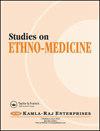真空干燥对几种常用药材营养保留的影响
Q2 Social Sciences
引用次数: 4
摘要
本文的目的是评估真空干燥对一些常用草药营养保留的影响。新鲜香草(罗勒叶(Ocimum teniflorum)、鸡腿叶(辣木油)和薄荷叶(Mentha))从卢迪亚纳PAU农学系采购。草本植物的叶子在50±5摄氏度的真空烘箱中清洗和干燥,研磨成粉末并储存在拉链袋中以备进一步使用。分析了草药的基本成分、矿物质(铁、锌和钙)、维生素(维生素C和β胡萝卜素)、生物活性化合物(总酚、类黄酮和抗氧化活性)和抗营养因子(藻毒素、磷和草酸盐)。干燥后蛋白质含量增幅最大的是BL(80.26%),其次是ML(77.91%)和DL(76.13%)。干燥后所有草本植物的水分含量均显著下降(p<0.01),而干燥后草本植物的灰分、粗蛋白质、粗脂肪、粗纤维、碳水化合物和能量含量显著增加(p<0.01)。BL、ML和DL中抗坏血酸含量的下降百分比分别为49.82、49.97和63.13%。鲜药材叶片中β-胡萝卜素含量在1489.2017992μg/100g和1989.01-32100μg/100k之间。干燥后,BL、ML和DL中的钙含量分别增加了74.01、82.88和82.78%,而BL、ML、DL中的锌含量分别为74.26、73.22和68.56%。DL、BL和ML等干燥草本植物的植酸酶和草酸盐含量分别增加了30.4%、25.9%和25.9%,以及16.8%、26.3%和12.4%。干燥后,BL、ML和DL中总酚含量的增加百分比分别为48%、49%和46%。干燥后,BL、ML和DL中DPPH含量的增加百分比分别为78.46%、82.82%和81.80%。ABTS干燥后TAC的增加百分比在BL中最大(87.85%),其次是ML(86.12%)和DL(74.03%)。新鲜香草叶的FRAP范围为112.05142.31 TE/100g,在干燥叶中为843.49-886.23 mg TE/100g。BL、ML和DL的百分比分别增加了83.12%、87.36%和79.27%。干燥后,生物活性物质含量显著增加(p<0.01)。结果表明,草药干燥后,除水分外,其基本成分、生物活性化合物、矿物质含量和β-胡萝卜素含量显著增加,维生素C和水分含量也有所下降。干燥后,鸡腿叶、罗勒叶和薄荷叶中的植酸酶含量增幅最大。本文章由计算机程序翻译,如有差异,请以英文原文为准。
Effect of Vacuum Drying On Nutrient Retention of Some Commonly Consumed Herbs
The objective of the paper was to evaluate the effect of vacuum drying on nutrient retention of some commonly consumed herbs. Fresh herbs (basil leaves (Ocimum tenuiflorum), drumstick leaves (Moringa oleifera) and mint leaves (Mentha)) were procured from Department of Agronomy, PAU, Ludhiana. The leaves of herbs were cleaned and dried in vacuum oven at 50±5oC, ground to form powder and stored in zip pouches for further use. Herbs were analysed for their proximate composition, minerals (iron, zinc and calcium), vitamins (vitamin C and βcarotene) bioactive compounds (total phenols, flavonoids and antioxidant activity), and anti-nutritional factors (phytin phosphorous and oxalates). The percent increase in protein content after drying was maximum in BL (80.26%) followed by ML (77.91%) and DL (76.13%). A significant decrease (p<0.01) was found in moisture content of all herbs after drying while ash, crude protein, crude fat, crude fibre, carbohydrate and energy content of herbs increased significantly (p<0.01) after drying. Percent decrease in ascorbic acid content was 49.82, 49.97 and 63.13 percent in BL, ML and DL, respectively. β-carotene content of leaves of fresh herbs ranged from 1489.2017992 μg/100g and 1989.01-32100 μg/100g in dried leaves. Calcium content increased by 74.01, 82.88 and 82.78 percent after drying in BL, ML and DL, while zinc content was 74.26, 73.22and 68.56 percent in BL, ML and DL. Dried herbs like DL, BL and ML increased in phytate and oxalate content by 30.4, 25.9 and 25.9 percent and 16.8, 26.3 and 12.4 percent, respectively. Percent increase in total phenol content after drying was 48, 49 and 46 percent in BL, ML and DL, respectively. Percent increase in DPPH content after drying was 78.46, 82.82 and 81.80 percent in BL, ML and DL, respectively. Percent increase in TAC by ABTS after drying was maximum in BL (87.85%) followed by ML (86.12%) and DL (74.03%). Range of FRAP for fresh leaves of herbs was 112.05142.31 TE/100g and it was 843.49-886.23 mg TE/100g in dried leaves. Percent increase was 83.12, 87.36 and 79.27 percent in BL, ML and DL, respectively. Content of bioactive compounds increased significantly (p<0.01) after drying. It was concluded that drying of herbs led to significant increase in proximate composition except moisture, in bioactive compounds, in mineral content and β-carotene, while a decrease in vitamin C and moisture content was also observed. Maximum percent increase of phytate content was found in drumstick leaves followed by basil leaves and mint leaves after drying.
求助全文
通过发布文献求助,成功后即可免费获取论文全文。
去求助
来源期刊

Studies on Ethno-Medicine
Social Sciences-Cultural Studies
CiteScore
0.50
自引率
0.00%
发文量
13
期刊介绍:
Studies on Ethno-Medicine is a peer reviewed, internationally circulated journal. It publishes reports of original research, theoretical articles, timely reviews, brief communications, book reviews and other publications in the interdisciplinary field of ethno-medicine. The journal serves as a forum for physical, social and life scientists as well as for health professionals. The transdisciplinary areas covered by this journal include, but are not limited to, Physical Sciences, Anthropology, Sociology, Geography, Life Sciences, Environmental Sciences, Botany, Agriculture, Home Science, Zoology, Genetics, Biology, Medical Sciences, Public Health, Demography and Epidemiology. The journal publishes basic, applied and methodologically oriented research from all such areas. The journal is committed to prompt review, and priority publication is given to manuscripts with novel or timely findings, and to manuscript of unusual interest. Further, the manuscripts are categorised under three types, namely - Regular articles, Short Communications and Reviews. The researchers are invited to submit original papers in English (papers published elsewhere or under consideration elsewhere shall not be considered).
 求助内容:
求助内容: 应助结果提醒方式:
应助结果提醒方式:


